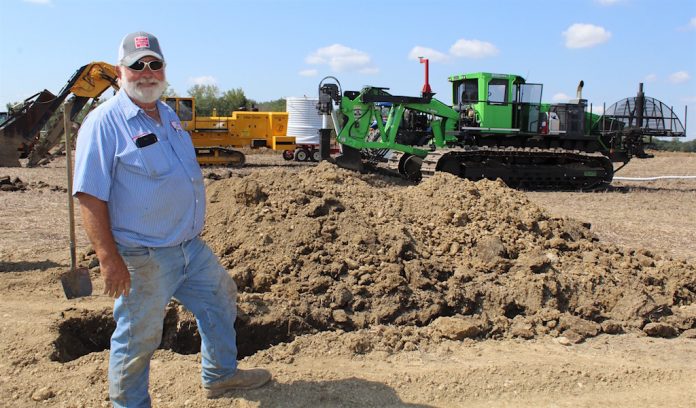LONDON, Ohio — The first step to increasing your crop production ability and yield may actually begin with the installation of good subsurface drainage.
A quality field tile system can get you in the field earlier in planting season, earlier during harvest, and can help regulate water and nutrient flow during the growing season, said Steve Gerten, at this year’s Farm Science Review, Sept. 18-20 in Madison County.
Gerten, of Inbody Drainage in Leipsic, Ohio, led tiling demonstrations at the Review with his son, Eric, who is president of the Ohio Land Improvement Contractors of America.
When the spring is a wet one, like it was in northeast Ohio this year, field tile will help a field dry faster and in some cases is the only way a field can be farmed.
“They’re (farmers) able to get on that field a few days earlier,” Steve Gerten said.
According to Ohio State University, about 60 percent of Ohio’s cropland needs drainage improvement to maximize production. The length of the drainage pipe installed in Ohio is enough to make three trips to the moon.
Nutrient control
When you control how fast the water leaves your field, you can also control how much fertilizer leaves the field. Field tile by itself will help reduce over-saturation of the soil, but coupled with a good water control structure, you can retain water in the field when you need it, and release it into the drainage system when you do not.
You can also determine the rate of flow, to some extent, based on how far open or closed you choose to operate your water control structure.
Gerten is currently working with Ohio State University to go a step further and develop phosphorus filters and woodchip bioreactors, which are placed where tile drains as a way of filtering nutrients and keeping them out of the watershed.
The goal is to develop a cost-effective design that would allow farmers to filter their field water, and apply the same nutrients back on their fields, once the filters become full.
Start smart
If you’ve been farming a property for any length of time, you probably know where the wet spots are and have a good idea of where you’d like to tile. First, make sure you’ve addressed the surface drainage, whether it’s through the installation of waterways and buffer strips, and/or the use of cover crops.
If you decide subsurface drainage is necessary, work with a reputable tile contractor to determine the cost per acre, where the water will be discharged, and the proper depth for your tile. According to Gerten, depth and spacing are determined by the type of soil in your field, with heavy clay soils usually requiring a shallower, tighter tile grid, while sandier soils allow for deeper tile, and a wider tile grid.
Know what’s there
You also want to have a good idea of existing tile drainage and any utility lines — water, gas or telecommunications.
The first field tiles installed on most farms were clay sections that were fitted together, followed by plastic. Today’s tile is corrugated plastic with perforations, and its flexibility and durability usually give it a long life.
As a professional contractor, Gerten works with the state’s One-Call tracking system, but he said it’s only as good as the information it has on file. He encourages utility companies to record their installations with their state’s One-Call system, even when not required.












You make a great point about paying cost per acre. I need to get a tiler for my field. I need a drainage field installed.